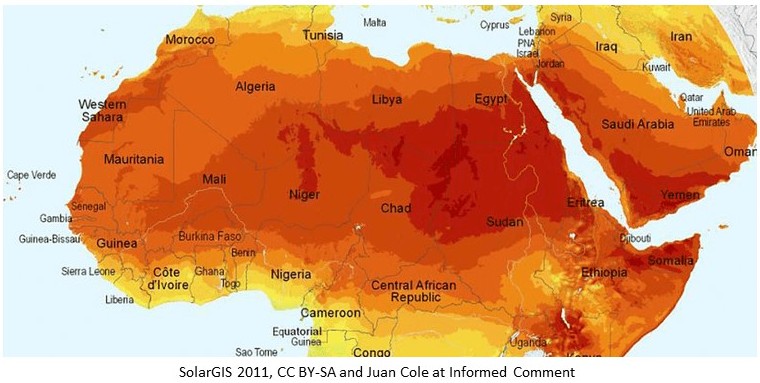Juan Cole at Informed Comment has a post up by Will de Freitas Should we cover the Sahara Desert with Solar Panels to Fight Climate Disaster? A map of North Africa is shown, with a surprisingly small box somewhere in Libya or Algeria shaded in. An area of the Sahara this size, the caption will say, could power the entire world through solar energy. Over the years various different schemes have been proposed for making this idea a reality. Though a company called Desertec caused a splash with some bold ideas a decade ago, it collapsed in 2014 and none of the other proposals to export serious amounts of electricity from the Sahara to Europe and beyond are anywhere close to being realized. An engineer at Nottingham Trent University has researched various
Topics:
run75441 considers the following as important: climate change, Hot Topics, Informed Commnt, Journalism, Juan Cole
This could be interesting, too:
NewDealdemocrat writes JOLTS revisions from Yesterday’s Report
Joel Eissenberg writes No Invading Allies Act
Joel Eissenberg writes How Tesla makes money
NewDealdemocrat writes January JOLTS report: monthly increases, but significant downward revisions to 2024
Juan Cole at Informed Comment has a post up by Will de Freitas Should we cover the Sahara Desert with Solar Panels to Fight Climate Disaster?
A map of North Africa is shown, with a surprisingly small box somewhere in Libya or Algeria shaded in. An area of the Sahara this size, the caption will say, could power the entire world through solar energy.
 Over the years various different schemes have been proposed for making this idea a reality. Though a company called Desertec caused a splash with some bold ideas a decade ago, it collapsed in 2014 and none of the other proposals to export serious amounts of electricity from the Sahara to Europe and beyond are anywhere close to being realized.
Over the years various different schemes have been proposed for making this idea a reality. Though a company called Desertec caused a splash with some bold ideas a decade ago, it collapsed in 2014 and none of the other proposals to export serious amounts of electricity from the Sahara to Europe and beyond are anywhere close to being realized.
An engineer at Nottingham Trent University has researched various options for Saharan solar, Amin Al-Habaibeh and discusses the sheer size of the Sahara desert and amount of sunshine it receives:
– It’s larger than Brazil, and slightly smaller than the US.
– If every ray of sunshine hitting s the Sahara was converted into energy, the desert would produce enough electricity over any given period to power Europe 7,000 times over.
So even a small chunk of the desert could indeed power much of the world, in theory. But how would this be achieved?
According to Amin Al-Habaibeh, there are two main technologies which can be applied to this project and each has their pros and cons:
– Concentrated solar power using lenses or mirrors to focus the sun’s energy in one spot, which becomes incredibly hot. This heat then generates electricity through a steam turbine.
– A tower in the middle of the mirror or lens is the “receiver” which then feeds heat to a generator.
– Some systems store the heat in the form of molten salt. This means they can release energy overnight, when the sun isn’t shining, providing a 24 hour per day supply of electricity.
– Concentrated solar power is very efficient in hot, dry environments, but the steam generators use large amounts of water.
– There are also the regular photovoltaic solar panels which are much more flexible and easier to set up, but less efficient in the very hottest weather.
Amin Al-Habaibeh: “Just a small portion of the Sahara could produce as much energy as the entire continent of Africa does at present. As solar technology improves, things will only get cheaper and more efficient. The Sahara may be inhospitable for most plants and animals, but it could bring sustainable energy to life across North Africa – and beyond.”
The issue may be in how to transmit the energy to other areas? Is it still transmission via immense cables?
The longer we delay, wait, deny, and ignore the issues we produced for climate; the more drastic the action to be taken. There is more to the discussion on producing power from the sun in the desert and worth exploring. In Juan Cole’s post: Should we cover the Sahara Desert with Solar Panels to Fight Climate Disaster? there are under sites identified in which to do similar installations.
